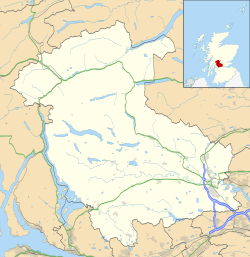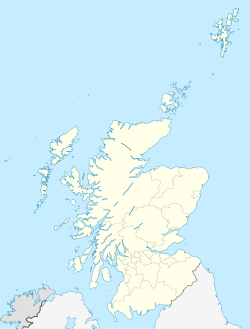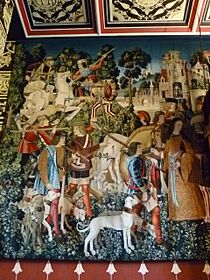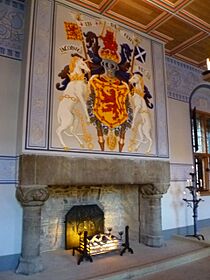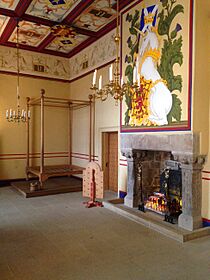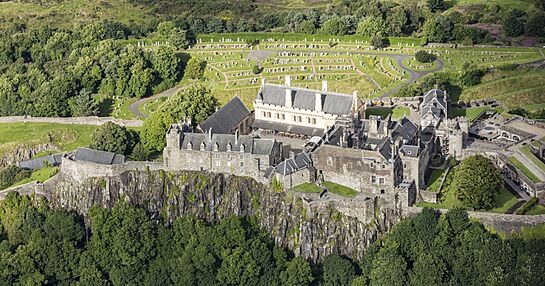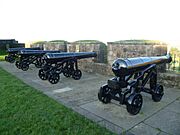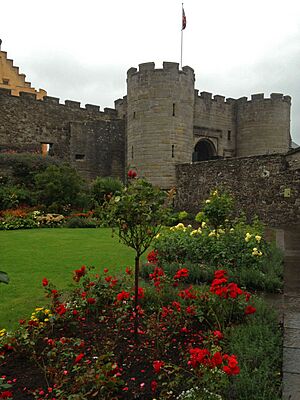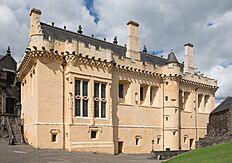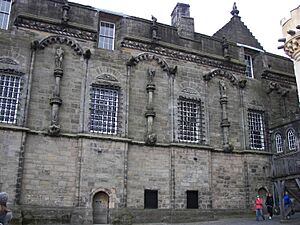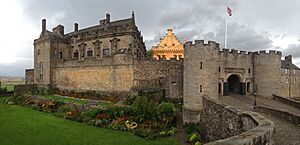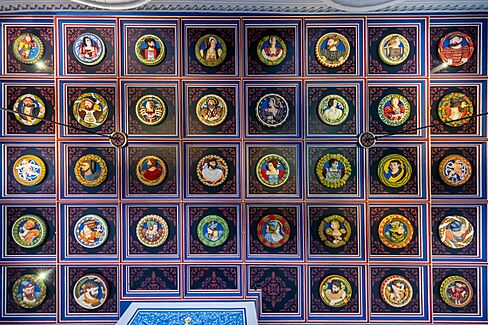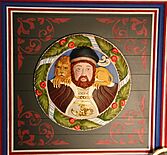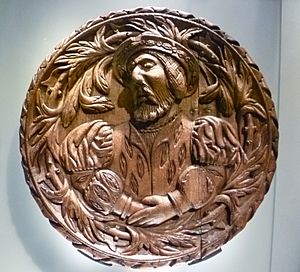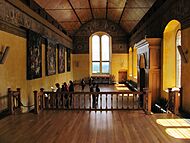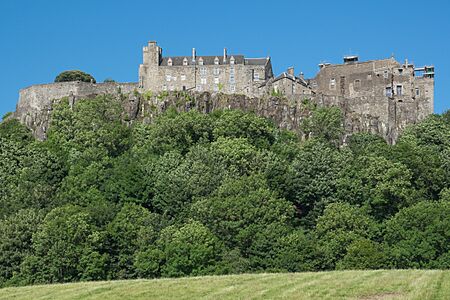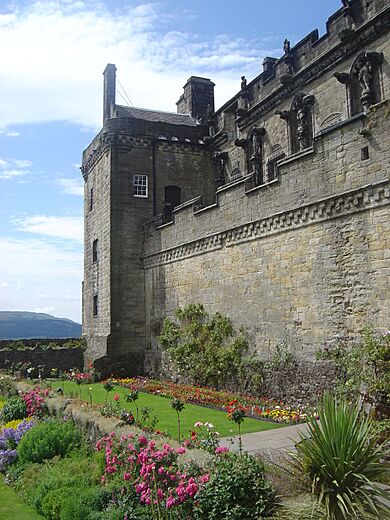Stirling Castle facts for kids
Quick facts for kids Stirling Castle |
|
|---|---|
| Stirling, Scotland | |

Aerial view of Stirling Castle
|
|
|
Location within Stirling council area
|
|
| Coordinates | 56°07′26″N 03°56′52″W / 56.12389°N 3.94778°W |
| Grid reference | grid reference NS789940 |
| Site information | |
| Owner | Historic Environment Scotland Ministry of Defence |
| Open to the public |
Yes |
| Site history | |
| Built | Castle dates from at least early 12th century, present buildings mostly built between 1490 and 1600 |
| Built by | Significant works by James IV, James V, and James VI |
| In use | Still in use today |
| Battles/wars | Sieges and occupations during the Wars of Scottish Independence (1296–1357); sieges in 1651, 1746 |
| Garrison information | |
| Current commander |
James Erskine, 14th Earl of Mar |
| Past commanders |
Hereditary office of the Earls of Mar |
Stirling Castle, located in Stirling, is one of the largest and most important castles in Scotland. It has a rich history and amazing architecture. The castle sits on top of a tall rock, which is like a natural fortress. This rock is surrounded by steep cliffs on three sides, making it very hard to attack.
Its location was super important because it guarded the lowest crossing point of the River Forth. This made it a key stronghold for hundreds of years. Most of the castle buildings you see today were built between the late 1400s and early 1600s. Some older parts from the 1300s still remain, and the outer defenses were added in the early 1700s.
Before Scotland and England joined, Stirling Castle was a favorite home for Scottish kings and queens, not just a fort. Many Scottish rulers were crowned here, including Mary, Queen of Scots, in 1542. Others were born or died within its walls.
Stirling Castle has been attacked at least eight times. Several of these attacks happened during the Wars of Scottish Independence. The last attack was in 1746, when Bonnie Prince Charlie tried but failed to capture it. Today, Stirling Castle is a protected ancient monument and a popular place for tourists, managed by Historic Environment Scotland.
Castle History
Early Days of Stirling Castle
The rock where Stirling Castle stands was formed about 350 million years ago. It was shaped by glaciers, creating a "crag and tail" feature, which is a rocky hill with a sloping ridge behind it. People probably lived on this hill very early on, as there's evidence of an ancient fort nearby.
The Romans didn't build a fort here, but the local people might have used the rock. Later, it might have been a stronghold called Urbs Iudeu. However, archaeologists haven't found proof of people living on Castle Hill before the late Middle Ages.
Some old stories say the Romans built forts here, or that Kenneth MacAlpin, Scotland's first king, attacked a castle at Stirling in the 800s. But these stories are not always reliable. Another legend connects Stirling with the famous King Arthur.
The first official mention of Stirling Castle is around 1110. King Alexander I built a chapel here and later died at the castle in 1124. His successor, David I, made Stirling a royal town, and the castle became an important center for the government.
King William I created a deer park for hunting near the castle. After he was captured by the English in 1174, he had to give up several castles, including Stirling, to England. But the English didn't actually stay there, and the castle was given back in 1189. Stirling remained a favorite royal home, and King William died there in 1214.
Wars of Independence and Stirling Castle
Stirling was a key royal center until King Alexander III died in 1286. His death led to a big problem: who would be the next king? Edward I of England was asked to help decide. In 1291, Edward came north and demanded control of Stirling and other Scottish castles during this process.
In 1296, Edward invaded Scotland, starting the Wars of Scottish Independence. These wars lasted for about 60 years. The English found Stirling Castle empty and took it over. But the next year, after the Scottish victory at the Battle of Stirling Bridge, the English were forced out. The English soldiers inside the castle were starved into surrendering.
The castle changed hands again after the English won the Battle of Falkirk in 1298. Edward made the castle stronger, but then Robert Bruce (who would become king) besieged it in 1299, and the English had to surrender again.
By 1303, the English were winning, and Stirling was the last castle still held by the Scots. Edward's army arrived in 1304 with many siege engines, including a huge one called "Warwolf." This giant machine destroyed the castle's gatehouse. The Scots surrendered, but Edward made some of them go back inside so he could test his new weapon!
Edward I died in 1307, and Robert Bruce became King of Scots. By 1313, only a few castles, including Stirling, were still held by the English. Robert Bruce's brother, Edward Bruce, besieged Stirling. The English commander, Sir Philip Mowbray, made a deal: he would surrender the castle if the English didn't rescue it within one year. Edward Bruce agreed.
This deal led to the famous Battle of Bannockburn in 1314. King Edward II of England came north to save the castle. But King Robert's forces defeated the English army right near the castle walls. Edward II tried to hide in the castle, but Mowbray kept his promise and wouldn't let him in. The English had to run away. Mowbray then handed over the castle to the Scots. King Robert ordered the castle's defenses to be destroyed so the English couldn't use it again.
The war wasn't over. The English took Stirling Castle again by 1336. But Robert Stewart, who would become King Robert II, took it back in 1341–1342.
Early Scottish Kings at Stirling
Under the early Stewart kings, Robert II (1371–1390) and Robert III (1390–1406), the oldest parts of the castle that still stand were built. The north gate, which you can still see today, was built on foundations from the 1380s.
In 1424, Stirling Castle became part of the marriage gift for King James I's wife, Joan Beaufort. After James was murdered in 1437, Joan and her young son, James II, found safety here.
In 1452, a dramatic event happened at Stirling Castle. King James II stabbed and killed William, 8th Earl of Douglas, because Douglas refused to end a dangerous alliance with other powerful nobles.
James III (1460–1488) was born at Stirling. He improved the gardens and the royal chapel. His wife died at the castle in 1486, and James himself died two years later in a battle very close to the castle.
A Royal Palace is Built

Almost all the main buildings you see at Stirling Castle today were built between 1490 and 1600. During this time, the Stewart kings James IV, James V, and James VI made Stirling a key royal center. The new buildings show a mix of English, French, and German styles, showing the Stewart family's connections across Europe.
James IV (1488–1513) had a grand royal court with artists and scientists. He wanted Stirling to be a palace that could compare with others in Europe. He built the King's Old Building, the Great Hall, and the Forework (a grand entrance). He also updated the royal chapel.
After James IV died in battle, his son, James V (1513–1542), became king. He was crowned in the royal chapel and grew up at the castle. James V continued his father's building plans, creating the amazing Royal Palace, which is the centerpiece of the castle.
James V also died young, leaving his wife, Mary of Guise, to finish the work. Their baby daughter, Mary, Queen of Scots, was brought to Stirling Castle for safety and was crowned in the chapel royal in 1543. She also grew up here until she was sent to France. In the 1550s, new artillery defenses were added to the castle's south side.
Queen Mary returned to Scotland in 1561 and often visited Stirling Castle. Her son, James VI, was born in the castle in 1566 and baptized there with big celebrations. James grew up within the castle walls, taught by a famous scholar.
In 1594, King James VI's first son, Prince Henry, was born at the castle. The current Chapel Royal was built especially for his baptism. This chapel completed the main courtyard of the castle. When James VI became King of England in 1603, the royal family moved to London, and Stirling's role as a royal home changed.
Stirling Castle as a Military Base
After the royal family left, Stirling Castle became mainly a military center. It was used as a prison for important people in the 1600s. King Charles I visited briefly in 1633.
After Charles I was executed, his son Charles II was crowned King of Scots. He was the last reigning monarch to live at the castle in 1650. But his forces were defeated by Oliver Cromwell's army. In 1651, General Monck besieged the castle. After the soldiers inside rebelled, the castle had to surrender. You can still see damage from this siege on the church and the Great Hall.
After Charles II became king again, the castle was often used as a prison. Its military role became more important, with a gunpowder storage building added and a permanent group of soldiers stationed there from 1685.
In 1715, a rebellion started to put James Stuart (the "Old Pretender") on the throne. Government troops quickly took over Stirling Castle. Another rebellion in 1745 saw Bonnie Prince Charlie's army pass Stirling. They returned in 1746 and took the town, but the castle governor refused to give up. The castle's guns quickly destroyed the rebels' artillery. The rebels soon left.
From 1800, the British Army owned the castle and used it as a barracks (a place for soldiers to live). Many changes were made: the Great Hall became a living area, the Chapel Royal became a lecture hall, and the Royal Palace became the officers' mess. New buildings like a prison and powder magazine were also built.
In 1881, the Argyll and Sutherland Highlanders regiment made the castle their main base.
Modern Times at Stirling Castle
The royal living areas have been beautifully restored to look like they did long ago. A big project, costing £12 million and lasting ten years, finished in 2011. Since 2002, a special studio has been recreating The Hunt of the Unicorn tapestries. Four of these are now hanging in the Queen's Presence Chamber in the Royal Palace. Historians believe similar tapestries were part of the Scottish royal collection.
Weavers studied the original 15th-century tapestries in New York City and researched old weaving methods. The project was completed in 2015.
Stirling Castle is still the headquarters of the Argyll and Sutherland Highlanders regiment. Their museum is also inside the castle.
Exploring the Castle
Outer Defences
The Outer Defences are like the castle's first line of protection. They were built mostly in the 1700s for cannons, but some parts, like the French Spur, date back to the 1550s. The French Spur was a special ear-shaped part that held guns to protect the main entrance.
After a planned invasion in 1708, the castle's defenses were made even stronger. The main front wall was extended to create Guardhouse Square. This gave the castle two defensive walls, both protected by ditches and covered firing tunnels called caponiers. One of these tunnels still exists and you can visit it.
Behind the walls, strong rooms called casemates were built to make the walls stronger and hold more guns. The buildings in Guardhouse Square are from the 1800s. Outside the castle is the Esplanade, a large open area used for parades and now for parking and events.
The Forework Gate
The main gatehouse that leads into the castle was built by King James IV around 1506. It was part of a larger "Forework" that stretched across the whole hill. The gatehouse itself is now less than half its original height. It used to have tall round towers with pointy roofs.
This Forework was probably built more to look impressive and show off the "age of chivalry" than for real defense against cannons. The entrance had a main passage for horses and two smaller ones for people. This triple entrance was unusual for its time. The gatehouse was slowly taken apart over the years and rebuilt into its current shape in 1810.
Outer Courtyard
Inside the Forework is a courtyard called the Outer Close. To the southeast are military buildings from the 1700s and 1800s. The old North Gate, which leads to the Nether Bailey, used to have the castle kitchens. The large Great Kitchen you see today was built later. However, in 1689, these rooms were filled with rubble to create platforms for cannons. The small building above the North Gate is traditionally said to have been a mint, where coins were made.
To the west of the Outer Close, the main parts of the castle are arranged around the Inner Close: the Royal Palace to the south, the King's Old Building to the west, the Chapel Royal to the north, and the Great Hall to the east.
King's Old Building

The King's Old Building is the oldest part of the Inner Close, finished around 1497. King James IV started it as a new home. The main rooms were on the first floor, with great views to the west. The inside has been changed a lot over time.
In 1855, the north end of the building burned down and was rebuilt in a Scottish style. A connecting building at the southwest end, once used as kitchens, might be even older, from the 1400s. Digs in this building in 1998 found burials, suggesting it might have been a church.
The Great Hall
On the east side of the Inner Close is the Great Hall, also called Parliament Hall. King James IV built this after 1497. It's been called "the grandest building built in Scotland in the late Middle Ages." It was the first royal building in Scotland to show Renaissance influences.
It was built by English craftsmen and has some English design ideas. It's about 42 meters long and 14.25 meters wide. Inside, there are five fireplaces and large windows.
The original wooden roof was removed in 1800 when the hall was divided into barracks for soldiers. It was split into two floors with five walls, and the windows were changed. People wanted to restore the Great Hall as early as 1893, but it wasn't until the army left in 1965 that it could happen. The restoration was finished in 1999, bringing back the original roof, windows, and white outer walls.
The Royal Palace
To the left of the gatehouse, on the south side of the Inner Close, is the Royal Palace. This was the first Renaissance palace in the British Isles, built by King James V. It mixes Renaissance style with detailed late-Gothic carvings, making it one of Scotland's most impressive buildings. It's covered with unique carved stonework. Building started in the 1530s and was mostly done by the late 1540s.
The architecture was inspired by France, but the decorations came from Germany. The statues include soldiers on the roof and full-size figures around the main floor. These figures include a portrait of James V, the Devil, St Michael, and gods and goddesses from ancient myths.
Inside, the Palace has two apartments, one for the king and one for the queen. Each has a hall, a room for meeting important people, and a bedroom, plus smaller rooms. The Renaissance decorations continued inside, but most were lost when the building was used by the military.
The ceiling of the King's Presence Chamber was decorated with carved oak circles called the Stirling Heads. These are considered "among the finest examples of Scottish Renaissance wood-carving." Some of the heads might have been made by a French carver. The carvings were taken down in 1777 after the ceiling collapsed. Out of about 56 original heads, 38 still exist. Most are now kept in the castle, and three are in the National Museum of Scotland.
Some of the portraits are thought to be of kings, queens, or people from the court, while others show figures from myths or the Bible. A £12 million project to bring back the grandeur of the Royal Palace opened to the public in June 2011. This restoration involved ten years of research and work, bringing six royal apartments back to how they looked in the 1540s, when Mary Queen of Scots lived there as a child. The project also included recreating seven hand-woven tapestries.
Stirling Heads
The Chapel Royal
The first royal chapel, built by James IV in 1501, was where Queen Mary was crowned in 1543. But when King James VI's first son, Prince Henry, was born in 1594, they decided to build a new chapel for his royal baptism.
The new building was built in just one year, north of the old site. This chapel, with its Italian-style arched windows, was designed by the Royal Master of Works William Schaw. The inside was painted before King Charles I visited in 1633. The chapel was also later changed for military use, becoming a dining room. The wall paintings were found again in the 1930s, and restoration began after World War II.
Nether Bailey
Beyond the North Gate, the Nether Bailey is at the northern end of Castle Hill. This area has defensive walls, a 19th-century guard house, and gunpowder storage buildings. There used to be an entrance from the west, but it was blocked to prevent Jacobite rebels from getting in.
Castle Gardens
There are two gardens inside the castle. Below the castle's west wall is the King's Knot, a formal garden from the 1500s. Today, you can only see its shape in the ground, but it once had hedges and patterned flowerbeds. The gardens were built on the site of a medieval jousting arena, called the Round Table, like the legendary court of King Arthur.
What's Happening Now
The castle esplanade, or parade ground, is used for outdoor concerts by famous musicians. It also hosts the city's New Year's Eve celebrations. The Regimental Museum is located in the King's Old Building. The museum closed for updates in 2018 and reopened in June 2021.
Stirling Castle is open to the public all year. It's a very popular place for tourists. In 2019, over 600,000 people visited!
An illustration of Stirling Castle is on the back of some £20 notes issued by the Clydesdale Bank, with Robert the Bruce on horseback in front.
Because it looks similar to Colditz Castle in Germany, Stirling Castle was used for filming the outside scenes of the 1970s TV show Colditz. This show was about Allied prisoners of war trying to escape from a military prison during World War II.
Castle Legends
Many ghost stories are told about Stirling Castle. The Green Lady is probably the most famous. Many visitors and people who work there say they have seen her. One popular story says the Green Lady was a maidservant who saved Queen Mary from danger. Many believe that seeing the Green Lady means something bad is about to happen, often a fire.
See also
 In Spanish: Castillo de Stirling para niños
In Spanish: Castillo de Stirling para niños
- Governor of Stirling Castle
- Banknotes of Scotland (featured on design)
- Castles in Great Britain and Ireland
- List of castles in Scotland


